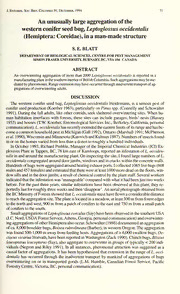
An unusually large aggregation of the western conifer seed bug, Leptoglossus occidentalis (Hemiptera: Coreidae), in a man-made structure PDF
Preview An unusually large aggregation of the western conifer seed bug, Leptoglossus occidentalis (Hemiptera: Coreidae), in a man-made structure
J.Entomol.Soc.Brit.Columbia91,December, 1994 71 An unusually large aggregation ofthe western conifer seed bug,Leptoglossus occidentalis (Hemiptera: Coreidae), in a man-made structure BLATT S. E. DEPARTMENTOFBIOLOGICALSCIENCES,CENTREFORPESTMANAGEMENT SIMONERASERUNIVERSITY,BURNABY,BC,V5A1S6 CANADA ABSTRACT An overwintering aggregation ofmore than 2000Leptoglossus occidentalis is reported in a manufacturingplantinthesoutherninteriorofBritishColumbia.Suchaggregationsmaybeme- diatedbypheromones.Rangeextensionmayhaveoccurredthroughinadvertenttransportofag- gregationsofoverwinteringadults. DISCUSSION The western conifer seed bug, Leptoglossus occidentalis Heidemann, is a serious pest of coniferseedproducrion (Koerber 1963), particularly onPinus spp. (Connelly andSchowalter 1991).Duringthe fall adults, like othercoreids, seek sheltered overwintering sites. Whenhu- man habitation interfaces with forests, these sites can include garages, birds' nests (Hussey 1953) andhouses (T.W. Koerber,Entomological Services Inc., Berkeley, California, personal communication).L.occidentalishasrecentiyextendedtheeasternlimitsofitsrangeandhasbe- comeacommonhouseholdpestinMichigan(Gall 1992),Ontario(Marshall 1991;McPherson etal. 1990),WisconsinandMinnesota(KatovichandKulman 1987).Numbersofinsectsfound inoronthehomesvariedfromlessthanadozentoroughlyahundred individuals. In October 1993, Richard Prebble, Managerofthe Imperial Chemical Industries (ICI) Ex- plosivesPlantinTappen, BC, 78 kmeastofKamloops, reported an infestationofL. occiden- talisinandaroundthemanufacturingplant.Oninspectingthe site,IfoundlargenumbersofL. occidentaliscongregatedarounddoorjambs,windowsandincrackswithintheconcretewalls. Hundredsofbugswereaggregatedaroundheatingexhaustports.Icollected 1065livebugs(608 malesand457females)andestimatedthattherewereatleast 1000moredeadonthefloors,win- dowsillsandinthedoorjambs; aresultofchemicalcontrolby theplantstaff. Severalworkers indicatedthattheinfestationwas'manageable' comparedwithwhatithadbeenjusttwoweeks before. Forthe pastthree years, similarinfestationshave been observed atthis plant; they re- portedlylastforroughlythreeweeksandthen'disappear'.Anaerialphotographobtainedfrom theBCMinistryofForestsshowedthatL.occidentalismusthaveflownaconsiderabledistance m toreachtheaggregationsite.Theplantislocatedinameadow,atleast300 fromforestedges m m tothenorthandwest,900 fromapatchofconiferstotheeastand750 fromasmallpatch ofconiferstothesouth. SmallaggregationsofLeptoglossuscorculus(Say)havebeenobservedinthesouthernUSA (J.C.Nord,USDAForestService,Athens,Georgia,personalcommunication)andoverwinter- ingaggregationsofotherHemipteraalsooccur.Schowalter(1986)documentedanaggregation ofca. 8,000boxelderbugs,Boisearubrolineata(Barber),inwesternOregon.Theaggregation wasfound500-1,000mawayfromfeedinghosts. Aggregationsof>6,000swallowbugs, Oe- ciacusvicariusHorvath,havebeenreportedinWashington(Zack 1990). Chinchbugs,Blissus leucopterusleucopterus (Say), alsoaggregate tooverwinterin groupsoftypically < 200 indi- viduals (Negron and Riley 1991). In all instances, pheromonal attraction was suggested as a causal factorofaggregations. Ithas beenhypothesized that extension in the range ofL. occi- dentalis has occurred through the inadvertent transport by mankind ofaggregations ofbugs overwintering on or in transported goods (L.M. Humble, Canadian Forest Service, Pacific ForestryCentre,Victoria,BC,personalcommunication). . . 72 J.Entomol.Soc.Brit.Columbia91,December, 1994 ACKNOWLEDGMENTS I thank Dr. J.H. Borden for review and R. Prebble for allowing me to collectbugs on ICI premises.FundingforthisworkwasprovidedbytheCanadianForestServiceandNaturalSci- encesandEngineeringResearchCouncilofCanada. REFERENCES Connelly,A.E.andT.D.Schowalter1991.SeedlossestofeedingbyLeptoglossusoccidentalis(Heteroptera:Coreidae) duringtwoperiodsofsecondyearconedevelopmentinWesternWhitePine.J.Econ.Entomol.83:1485-1486. Gall,W.K. 1992.FurthereasternrangeextensionandhostrecordsforLeptoglossusoccidentalis(Heteroptera:Corei- dae):well-documenteddispersalofahouseholdnuisance.GreatLakesEntomol.25:159-171 Hussey,R.F. 1953.ConcerningsomeNorthAmericanCoreidae(Hemiptera).Bull.BrooklynEntomol.Soc.48:29-34. Katovich,S.A.andH.M.Kulman1987.LeptoglossuscorculusandLeptoglossusoccidentalis(Hemiptera:Coreidae)at- tackingredpine,Pinusresinosa,conesinWisconsinandMinnesota.GreatLakesEntomol.20:119-120. Koerber,T.W. 1963.Leptoglossusoccidentalis(Hemiptera: Coreidae) anewlydiscoveredpestofconiferous seed. Ann.Entomol.Soc.Amer.56:229-234. Marshall,S.A. 1991.AnewOntariorecordofaseedeatingbug(Hemiptera:Coreidae)andotherexamplesoftherole ofregionalinsectcollectionsintrackingchangestoOntario'sfauna.Proc.Entomol.Soc.On. 122:109-111 McPherson,J.E.,R.J.Packauskas,S.J.TaylorandM.F.O'Brien 1990.EasternrangeextensionofLeptoglossusocci- dentaliswithakeytoLeptoglossusspeciesofAmericanorthofMexico(Heteroptera:Coreidae).GreatLakesEn- tomol.23:99-104. Negron,J.F.andT.J.Riley 1991.Seasonalmigratonandoverwinteringofthechinchbug(Hemiptera: Lygaeidae)in Louisiana.J.Econ.Entomol.84:1681-1685. Zack,R.S. 1990.Swallowbug(Heteroptera:Cimicidae)inWashingtonwithanunusualoverwinteringsite.PanPac. Entomol.66:251-252.
